|
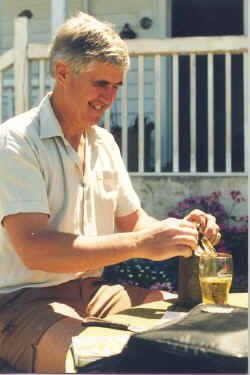 Tasmania,
according to Encyclopaedia Britannica, is "an island of
plateaux, platforms, and rugged ranges" which "exhibits the
most spectacular mountain scenery in Australia". But it was not
mountain scenery that attracted George Mure and his wife to Tasmania, an
island on the other side of the world from Caldwell in Scotland, the
Mures' ancestral home, but an intriguing chain of events, a mutual love
of the sea and an enthusiasm that enabled them to rise to a series of
challenges. Tasmania,
according to Encyclopaedia Britannica, is "an island of
plateaux, platforms, and rugged ranges" which "exhibits the
most spectacular mountain scenery in Australia". But it was not
mountain scenery that attracted George Mure and his wife to Tasmania, an
island on the other side of the world from Caldwell in Scotland, the
Mures' ancestral home, but an intriguing chain of events, a mutual love
of the sea and an enthusiasm that enabled them to rise to a series of
challenges.
But, before exploring the New World life
and achievements of the Mure family, let us delve back some seven
centuries, and 300 years before Tasmania was "discovered" by
the Dutch navigator Abel Tasman in 1642, to investigate the Scots
lineage and some of the history of the family.
According to Burke's Landed Gentry,
George Mure's family is directly descended from Sir Reginald More, or
Mure, of Abercorn and Cowdams who, as far as is known, was Chamberlain
of Scotland as early as 1329. It was Sir Reginald's younger son,
Gilchrist More, who acquired the estate of Caldwell in Ayrshire and
Renfrewshire through marriage with the heir of Caldwell, of that ilk.
The family pedigree also shows descent from the Mures (or variously
Moores, Mores or Muirs) of Rowallan (or Rouallan).
Feudal strife and "slauchter"
Feudal strife was commonplace in Scotland
in bygone centuries, and the Mure family was as involved as any. In
1500, according to the family records, The Caldwell Papers, Robert
Mure, a son of Adam Mure of Caldwell, was granted a Remission under the
Privy Seal for the "slauchter of umquhile Patrick Boure, and for
the forthocht fellony done upon the Laird of Ralston". Sir Adam's
second son, John, described as "a bold and turbulent baron",
fought against the government of the Duke of Albany and was involved in
the sacking of the "Castle and Palace" of Glasgow in 1515. A
consequent action for damages for the destruction and plunder of these
properties forced him to mortgage his estate of Camseskane.
A generation later, this laird's son,
also called John, took part in 1543 in "the bloody battle called
the Field of the Muir of Glasgow". Six years later he was indicted
for having "with his fyve brothers and twenty-six others, armed in
warlike manner, invaded Robert Master of Sempill and his servands for
their slauchter, near the place and tour of Cauldwell, and put them to
flight".
The Mures, of course, were also at times
the victims. Robert Mure, one of the three sons of John Mure, was slain
by "Sir Patrick Houstoun of that ilk, and others" in 1550, in
a "crewall slauchter, committed under silence of night, on actient
feud and forthocht felony". Despite the conviction and beheading of
Sir Patrick for the crime, a feud was to rage between the Houstouns and
the Mures for the next thirty years. A clan feud also claimed the life
of Robert's son, Sir John (he had been knighted by James V), who, in
1570, was killed by the Cuninghams of Aitkett and the Ryeburns of that
ilk. Other misfortunes, violent disputes and "murderous deeds"
were to characterise the history of later generations.
 Moving
forward to the seventeenth century we find William Mure of Caldwell who,
as mentioned in Burke's Landed Gentry, was "attainted for
joining the Covenanters, fled to Holland, and died in exile". His
support for the Presbyterian cause and role in the rebellion against the
English monarchy led to seizure of his estates which were granted to
"the celebrated" General Dalziel – an "Inglisman"
who subsequently destroyed Caldwell Castle (just one tower still stands
today). Moving
forward to the seventeenth century we find William Mure of Caldwell who,
as mentioned in Burke's Landed Gentry, was "attainted for
joining the Covenanters, fled to Holland, and died in exile". His
support for the Presbyterian cause and role in the rebellion against the
English monarchy led to seizure of his estates which were granted to
"the celebrated" General Dalziel – an "Inglisman"
who subsequently destroyed Caldwell Castle (just one tower still stands
today).
Mure's unfortunate wife, meanwhile, was
imprisoned with two of her daughters in Blackness Castle where she
"underwent much cruel persecution". One of her daughters,
Anne, was to die as a result. As Anne lay mortally ill in the house of
relatives, not far from Blackness, her mother appealed to be allowed to
visit her: "Yet such was the unnatural cruelty of the times that so
reasonable a request could not be granted." Some ten years later
Barbara, the other imprisoned daughter, was, by special Act of
Parliament, granted a full restitution of the patrimonial estates".
Historic upheavals
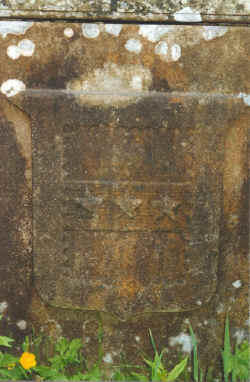 The
Mure family were to be witnesses of, or participants in, several other
historic upheavals. "In the eighteenth century," relates
George Mure, "a later William Mure was Member of Parliament for
Renfrewshire from 1742 to 1761, and one of the Barons of the Scottish
Exchequer. It was this Baron Mure who built Caldwell House. During this
period, in 1745, a Jacobite rebellion incited by Charles Edward, the son
of King James II, led to the fall of Perth and then Edinburgh to the
rebels. Prince Charles endeavoured to pursue his campaign into England
but absence of support led to his retreat from Derby back to Scotland in
December of that year. Over the next four months, his forces were
weakened by desertions and, despite a memorable success at Falkirk, they
were forced ever northwards by the government army, to be defeated at
the Battle of Culloden in the spring of 1746. The
Mure family were to be witnesses of, or participants in, several other
historic upheavals. "In the eighteenth century," relates
George Mure, "a later William Mure was Member of Parliament for
Renfrewshire from 1742 to 1761, and one of the Barons of the Scottish
Exchequer. It was this Baron Mure who built Caldwell House. During this
period, in 1745, a Jacobite rebellion incited by Charles Edward, the son
of King James II, led to the fall of Perth and then Edinburgh to the
rebels. Prince Charles endeavoured to pursue his campaign into England
but absence of support led to his retreat from Derby back to Scotland in
December of that year. Over the next four months, his forces were
weakened by desertions and, despite a memorable success at Falkirk, they
were forced ever northwards by the government army, to be defeated at
the Battle of Culloden in the spring of 1746.
"The reaction of the London
Parliament to the rebellion was to pass a Disarming Act which banned not
only weaponry but also bagpipes and Highland dress. Other laws curtailed
the powers of clan chiefs over their tenants and abolished the bond of
military service between chief and clansmen."
Letters about the rebellion collected in The
Caldwell Papers speak of "unnatural rebellion", "the
entry of 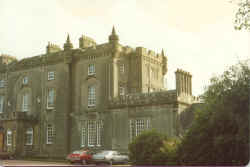 the
rebell army into Edinburgh", and an attack by the rebels on the
king's army which, at one point, led to "a panick into the foot,
which was greatly increased by the cries and confusion of many thousands
of spectators…" – a rather intriguing vision! The writer of
this particular account describes "this memorable battle, at which
I was present, and in which about 7000 of the best troops in the world
fled like so many children before half that number of undisplined
militia". The rebels, nonetheless, were eventually forced into
retreat by the Duke of Cumberland's forces. the
rebell army into Edinburgh", and an attack by the rebels on the
king's army which, at one point, led to "a panick into the foot,
which was greatly increased by the cries and confusion of many thousands
of spectators…" – a rather intriguing vision! The writer of
this particular account describes "this memorable battle, at which
I was present, and in which about 7000 of the best troops in the world
fled like so many children before half that number of undisplined
militia". The rebels, nonetheless, were eventually forced into
retreat by the Duke of Cumberland's forces.
Meanwhile a certain Archibald Stuart,
wine-merchant, Lord Provost and MP for the city of Edinburgh, and a
mutual friend of John Coutts, an influential banker, and of William Mure,
was accused of  "favouring
the Pretender and conniving at the occupation of the town by the rebell
force". To his friends' relief, no doubt, Stuart was honourably
acquitted at his trial. "favouring
the Pretender and conniving at the occupation of the town by the rebell
force". To his friends' relief, no doubt, Stuart was honourably
acquitted at his trial.
Farther afield, thirty-six years later,
William Mure's son, William, was to serve in America as a captain in his
Britannic Majesty's 82nd Regiment of Foot, which was forced into
capitulation at Yorktown in October 1781. As America won its
independence, Capt. Mure was made a prisoner of war.
A very secret service
 In
more recent history, William Mure, grandson of the first Lord Leconfield
and head of his sept, the Mures of Caldwell, died in 1912 leaving a son,
David William Alexander Mure who was born that same year at Eglinton
Castle, Ayrshire. David Mure was the last of his family to be born in
Scotland. In
more recent history, William Mure, grandson of the first Lord Leconfield
and head of his sept, the Mures of Caldwell, died in 1912 leaving a son,
David William Alexander Mure who was born that same year at Eglinton
Castle, Ayrshire. David Mure was the last of his family to be born in
Scotland.
George explains that "At the
outbreak of WWII, David Mure, my father, enlisted in the Royal Norfolk
Regiment and was soon commissioned into the 60th Rifles. Initially he
served in the Western Desert but was then enlisted by the so-called 'A'
Force. The overt role of this Middle East-based operation was to train
soldiers in escape methods. In practice, it was involved in top-secret
work, using the radio sets of double agents to feed back misleading
information to the German Abwehr. Work on breaking the codes used
by the famed Enigma machine was crucial to the operation.
"The method was ingenious. Each
agent had a team of imaginary contacts and sub-agents. As my father
described it in his book Practise to Deceive: 'The agent's
wireless transmissions or letters to his Abwehr controllers would
duly contain the latest news from his notional team. Enormous trouble
was taken to endow each notional contact or sub-agent with a character
of his own, with quirks and idiosyncrasies which were lovingly
maintained throughout each transmission rather as in a long-running
radio or television serial. The transmissions or letters were, of
course, composed by us, and similar care was taken to preserve the
principal agent's character and maintain the impression of his busy life
spent spying for the Germans.'
"The deception was reinforced by
what my father described as 'fabricated invasion flotillas, tanks,
aircraft, etc. and a system of displaying false divisional signs
converting non-operational to operational formations'. He also
attributed the success of these operations to the always tacit and
sometimes, he believed, active connivance of the chief of the Abwehr,
Admiral Canaris, and his colleagues of the Schwarze Kapelle, the
anti-Nazi conspirators within the German General Staff.
"Of enormous importance to the
Allied war effort, the 'A' Force's skills at deception successfully
diverted the Germans from planned Allied invasions of the Sicilian and
Normandy coasts by encouraging them to focus on a forthcoming, but
entirely fictitious, invasion of the Balkans by the Allies."
The Mures in Tasmania
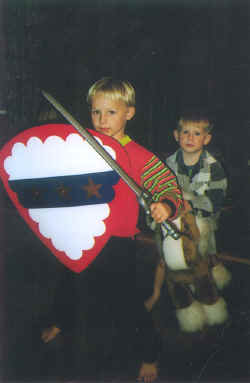 David
Mure's son George, the current head of the family, has also led a
somewhat unusual, and decidedly colourful, life. Born in London in 1939,
during the war years he lived on his great uncle's estate in Norfolk
where learned to row and fish. George then moved to Kenya at the age of
eight when his mother remarried. While boarding school life was tough
there for a posh "Pongo" (the nickname given to English boys),
holidays in Kenya, he recalls, were wonderful… and fishing became his
passion. David
Mure's son George, the current head of the family, has also led a
somewhat unusual, and decidedly colourful, life. Born in London in 1939,
during the war years he lived on his great uncle's estate in Norfolk
where learned to row and fish. George then moved to Kenya at the age of
eight when his mother remarried. While boarding school life was tough
there for a posh "Pongo" (the nickname given to English boys),
holidays in Kenya, he recalls, were wonderful… and fishing became his
passion.
"I fell totally in love with the
East African coast, both above and below the water," says George.
"Most school holidays were spent at Shimoni where I had the use of
a twenty-foot gaff-rigged boat, ideal for getting out to the many coral
islands and reefs. I swam, fished and goggled, taking my catch back to
the East African Fisheries factory managed by a family friend."
George's love of the sea and fishing led
him to start painting the fish he speared, building up a substantial
collection of paintings and accompanying notes. He entered this
collection in the Three-Nation Natural History Competition for secondary
schools in Kenya, Tanganyika and Uganda, and won the Swinerton and Burt
Natural History prize. "As a result," says George, "I was
hooked on fish for life. I knew that I wanted to be a fisherman."
His parents, perhaps understandably, had
other aspirations for their son. George was sent back to London to
matriculate and then embarked on a medical career. However, he failed
his exams at the end of the first year, "and left for Australia
under a slight cloud".
For two years George worked in a variety
of jobs, ranging from a year as a jackeroo in northern New South Wales
and a period taking tourists big game fishing in the Seychelles, to a
stint as a fish filleter on Tasmania's east coast.
Again George's parents intervened, this
time enrolling him in the Royal Agricultural College in Cirencester.
There George enjoyed himself thoroughly, meeting at a ball "a very
beautiful blonde with a healthy sun tan, and wearing a revealing yellow
evening dress". Jill was the daughter of the manager of Scotts in
Piccadilly, which had the reputation as Britain's best seafood
restaurant. Fine cuisine, and the restaurant industry, were her
passions. "We became good friends," says George. And, in 1962,
Jill and George married, and set sail for Australia.
Sydney was their first port of call and
there George joined a fish marketing company, Ross Fisheries, which sent
him to Hobart, Tasmania to buy and sell fish. "At the end of
1962," recalls George, "we bought the Pilot's House at
Tinderbox in Tasmania, a delightful Victorian weatherboard dwelling
right on the heads dividing the Derwent River from the D'Entrecasteaux
Channel. We still live there and it has been our spiritual home wherever
we have wandered".
"In 1964, I was promoted to be
Melbourne manager of Ross Fisheries – and that year, our son, William,
was born. The job and city living did not appeal to us so, in 1965, we
up-anchored and went to Western Australia where we went into business
for ourselves. We bought a 42 ft lobster boat called the Aquanita –
and this was to be the start of our fishing career. That same year our
daughter, Sarah, was born – a good omen!"
The experience built up by the Mures was
substantial. In Darwin they joined five other West Australian boats to
form a small fishing fleet to supply a factory ship. Finding the Aquanita
too small, they then bought a 70 ft tug and converted her into a
trawler. And they took the children, aged three and four, to New Guinea
in their wider search for prawns…
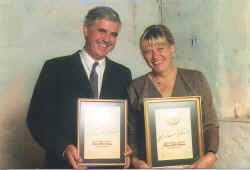 There
were other adventures too… bad weather, maritime rescues, and a huge
financial loss resulting from a crooked insurance broker. Each was part
of a chain of events that eventually led the Mures to return to Tasmania
where they bought a Victorian cottage at Battery Point and opened it as
Mures Fish House – a restaurant that was a huge success from the
moment it opened in 1973. In 1986 this restaurant was to win the Remy
Martin/Bulletin award for Best Seafood Restaurant in Australia. There
were other adventures too… bad weather, maritime rescues, and a huge
financial loss resulting from a crooked insurance broker. Each was part
of a chain of events that eventually led the Mures to return to Tasmania
where they bought a Victorian cottage at Battery Point and opened it as
Mures Fish House – a restaurant that was a huge success from the
moment it opened in 1973. In 1986 this restaurant was to win the Remy
Martin/Bulletin award for Best Seafood Restaurant in Australia.
Mures Fish House was both the catalyst
for the Mures' entry into the restaurant business, and for their
re-entry into fishing. Discovering how difficult it was to ensure a
regular supply and good variety of fresh fish, they started Australia's
first commercial mussel farm at Margate. They also formed a joint
venture with Hazell Brothers to start a boat-building factory to produce
fibre-glass fishing vessels.
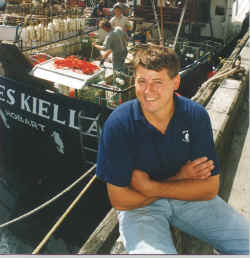 In
1985 the Mures joined a venture to develop a waterfront fish centre on
the dockside of Hobart's Sullivans Cove. Having bought out their
partners in 1990, this became a family-owned business run by their son
William and his wife Judy, daughter Sarah and her husband Rick McMahon.
George describes the business as "a 200-seat, licensed à la carte
seafood restaurant, a self-service licensed bistro, a licensed sushi
bar, and a fish factory capable of servicing our own business and the
fresh wholesale trade of Hobart. We have also now bought a 54 ft fishing
boat. William, our son, is the skipper and, until a relief skipper can
be trained up, I have to sometimes don my oilies and sea boots and
return to sea to give Will a break..." – a role that clearly
doesn't daunt George one iota. The Mures are now one of the largest
owners of fishing quotas in the State of Tasmania. In
1985 the Mures joined a venture to develop a waterfront fish centre on
the dockside of Hobart's Sullivans Cove. Having bought out their
partners in 1990, this became a family-owned business run by their son
William and his wife Judy, daughter Sarah and her husband Rick McMahon.
George describes the business as "a 200-seat, licensed à la carte
seafood restaurant, a self-service licensed bistro, a licensed sushi
bar, and a fish factory capable of servicing our own business and the
fresh wholesale trade of Hobart. We have also now bought a 54 ft fishing
boat. William, our son, is the skipper and, until a relief skipper can
be trained up, I have to sometimes don my oilies and sea boots and
return to sea to give Will a break..." – a role that clearly
doesn't daunt George one iota. The Mures are now one of the largest
owners of fishing quotas in the State of Tasmania.
Mures in Tasmania has become an
institution and a place of pilgrimage for lovers of seafood dishes –
so, as George rather modestly puts it: "The Scottish influence is
alive and well in Tasmania…" While relishing such fine dishes as
oyster soup, sashimi mille feuille, Tasmanian salmon in boronia oils, or
warm seafood salad, tuned-in diners hearing the creak of rigging,
lapping of water and keening of seagulls on the dockside will surely
gain some inkling into the Mures' long love affair with the sea.
Thanks
to Burke's Landed Gentry for sending in this information |

